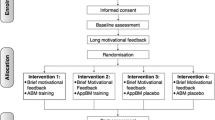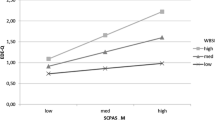Abstract
Experiential avoidance (EA) has been shown to be an important etiological and maintenance factor in a wide range psychopathology that includes addictive, anxiety, depressive and impulse control disorders. One common form of EA is thought suppression. Problem gambling causes enormous problems for afflicted individuals and has major social costs for their families and the community. Despite increasing interest in the contribution of EA to a broad range of psychological problems, its association with problem gambling has not previously been empirically investigated. The purpose of this cross-sectional study was to investigate the relationship between EA, thought suppression, and mindfulness among a group of 103 treatment seeking problem gamblers. Of particular interest was the extent to which EA accounted for the relationships between problem gambling and the two theoretically opposing constructs: thought suppression and mindfulness. Results showed EA was predictive of problem gambling. Thought suppression was positively associated and mindfulness negatively associated with problem gambling, and these relationships were mediated by EA. Directions for future research are suggested which include the application of treatments for problem gambling that undermine EA, such as acceptance and mindfulness based therapies.
Similar content being viewed by others
References
Baron, R. M., & Kenny, D. A. (1986). The moderator-mediator variable distinction in social psychological research: Conceptual, strategic, and statistical considerations. Journal of Personality and Social Psychology, 51(6), 1173–1182.
Begotka, A. M., Woods, D. W., & Wetterneck, C. T. (2004). The relationship between experiential avoidance and the severity of trichotillomania in a nonreferred sample. Journal of Behavior Therapy and Experimental Psychiatry, 35(1), 17–24.
Blaszczynski, A. (1999). Pathological gambling and obsessive-compulsive spectrum disorders. Psychological Reports, 84(1), 107–113.
Blaszczynski, A., Wilson, A., & McConaghy, N. (1986). Sensation seeking and pathological gambling. British Journal of Addiction, 81(1), 113–117.
Bond, F. W., Hayes, S. C., Baer, R. A., Carpenter, K. C., Guenole, N., Orcutt, H. K., et al. (2011). Preliminary psychometric properties of the acceptance and action questionnaire—II: A revised measure of psychological flexibility and acceptance. Behavior Therapy, 42, 676–688.
Brown, K. W., & Ryan, R. M. (2003). The benefits of being present: Mindfulness and its role in psychological well-being. Journal of Personality and Social Psychology, 84(4), 822–848.
Caselli, G., & Spada, M. M. (2010). Metacognition in desire thinking: A preliminary investigation. Behavioural and Cognitive Psychotherapy, 38(5), 629–637.
Dannon, P. N., Aizer, A., & Lowengrub, K. (2006). Kleptomania: Differential diagnosis and treatment modalities. Current Psychiatry Reviews, 2(2), 281–283.
de Lisle, S. M., Dowling, N. A., & Allen, J. S. (2011). Mindfulness-based cognitive therapy for problem gambling. Clinical Case Studies, 10(3), 210–228.
Eifert, G. H., & Forsyth, J. (2005). Acceptance and commitment therapy for anxiety disorders. Oakland CA: New Harbinger Publications, Inc.
Eifert, G. H., Mckay, M., & Forsyth, J. (2006). ACT on life not anger. Oakland CA: New Harbinger Publications, Inc.
Ferris, J. A., & Wynne, H. J. (2001). The Canadian problem gambling index: Final report. Canada: Canadian Centre on Substance Abuse.
Fledderus, M., Bohlmeijer, E. T., Pieterse, M. E., & Schreurs, K. M. D. (2012). Acceptance and commitment therapy as guided self-help for psychological distress and positive mental health: A randomised controlled trial. Psychological Medicine, 42(3), 485–495.
Grossman, P., Niemann, L., Schmidt, S., & Walach, H. (2004). Mindfulness-based stress reduction and health benefits: A meta-analysis. Journal of Psychosomatic Research, 57(1), 35–43.
Hayes, S. C. (1987). A contextual approach to therapeutic change. In N. Jacobson (Ed.), Psychotherapists in clinical practice: Cognitive and behavioral perspectives (pp. 327–387). New York: Guilford Press.
Hayes, S. C., Luoma, J. B., Bond, F. W., Masuda, A., & Lillis, J. (2006). Acceptance and commitment therapy: Model, processes and outcomes. Behaviour Research and Therapy, 44(1), 1–25.
Hayes, S. C., & Pierson, H. (2005). Acceptance and commitment therapy In A. Freeman, S. Felgoise, H., C. Nezu, M., A. Nezu, M. & M. Reinecke, A. (Eds.), Encyclopedia of Cognitive Behavior Therapy (pp. 1–4). US: Springer.
Hayes, S. C., Wilson, K. G., Gifford, E. V., Follette, V. M., & Strosahl, K. (1996). Experiential avoidance and behavioral disorders: A functional dimensional approach to diagnosis and treatment. Journal of Consulting and Clinical Psychology, 64(6), 1152–1168.
Hosmer, D., & Lemeshow, S. (2000). Applied logistic regression (2nd ed.). New York: Wiley.
Kabat-Zinn, J. (1990). Full catastrophe living: Using the wisdom of your body and mind to face stress, pain, and illness. New York: Delta.
Kabat-Zinn, J. (1994). Wherever you go, there you are: Mindfulness meditation in everyday life. New York: Hyperion.
Kashdan, T. B., Barrios, V., Forsyth, J. P., & Steger, M. F. (2006). Experiential avoidance as a generalized psychological vulnerability: Comparisons with coping and emotion regulation strategies. Behaviour Research and Therapy, 44(9), 1301–1320.
Lakey, C. E., Campbell, W. K., Brown, K. W., & Goodie, A. S. (2007). Dispositional mindfulness as a predictor of the severity of gambling outcomes. Personality and Individual Differences, 43(7), 1698–1710.
Lavender, J. M., Jardin, B. F., & Anderson, D. A. (2009). Bulimic symptoms in undergraduate men and women: Contributions of mindfulness and thought suppression. Eating Behaviors, 10(4), 228–231.
Lillis, J., Hayes, S. C., & Levin, M. E. (2011). Binge eating and weight control: The role of experiential avoidance. Behavior Modification, 35(3), 252–264.
Lindberg, A., Fernie, B. A., & Spada, M. M. (2011). Metacognitions in problem gambling. Journal of Gambling Studies, 27(1), 73–81.
Marlatt, A., & Gordon, J. (Eds.). (1985). Relapse prevention maintenance strategies in the treatment of addictive behaviours. USA: Guliford Press.
Marotta, J. J. (2002). Experiential avoidance as a functional process of problem gambling. In Marotta, J. J., Cornelius, J. A., & Eadington, W. R. (Eds.), The downside of problem and pathological gambling (pp. 69–91). Reno, Nevada, USA: University of Nevada Press.
McConaghy, N. (1980). Behaviour completion mechanisms rather than primary drives maintain behavioural patterns. Activitas Nervosa Superior, 22(2), 138–151.
McCormick, R. (1994). The importance of coping skill enhancement in the treatment of the pathological gambler. Journal of Gambling Studies, 10(1), 77–86.
Nower, L., Derevensky, J., & Gupta, R. (2004). The relationship of impulsivity, sensation seeking, coping, and substance use in youth gamblers. Psychology of Addictive Behaviors, 18(1), 49–55.
Orcutt, H. K., Pickett, S. M., & Pope, E. B. (2005). Experiential avoidance and forgiveness as mediators in the relationship between traumatic interpersonal events and posttraumatic stress disorder symptoms. Journal of Social and Clinical Psychology, 24(7), 1003–1029.
Purdon, C. (1999). Thought suppression and psychopathology. Behaviour Research and Therapy, 37(11), 1029–1054.
Stucki, S., & Rihs-Middel, M. (2007). Prevalence of adult problem and pathological gambling between 2000 and 2005: An update. Journal of Gambling Studies, 23(3), 245–257.
Sylvain, C., Ladouceur, R., & Boisvert, J. M. (1997). Cognitive and behavioral treatment of pathological gambling: A controlled study. Journal of Consulting and Clinical Psychology, 65(5), 727–732.
Toll, B. A., Sobell, M. B., Wagner, E. F., & Sobell, L. C. (2001). The relationship between thought suppression and smoking cessation. Addictive Behaviours, 26(4), 509–515.
Toneatto, T. (2002). Cognitive therapy for problem gambling. Cognitive and Behavioral Practice, 9(3), 191–199.
Toneatto, T., Vettese, L., & Nguyen, L. (2007). The role of mindfulness in the cognitive-behavioural treatment of problem gambling. Journal of Gambling Issues (19)19, 91–100.
Walker, D. M. (2008). Clarification of the social costs of gambling. Journal of Public Budgeting, Accounting & Financial Management, 20(2), 141–152.
Wegner, D. M., Schneider, D. J., Carter, S. R., & White, T. L. (1987). Paradoxical effects of thought suppression. Journal of Personality and Social Psychology, 53(1), 5–13.
Wegner, D. M., & Zanakos, S. (1994). Chronic thought suppression. Journal of Personality, 62(4), 615–640.
Wells, A. (2008). Metacognitive therapy: Cognition applied to regulating cognition. Behavioural and Cognitive Psychotherapy, 36(6), 651–658.
Wenzlaff, R. M., & Luxton, D. D. (2003). The role of thought suppression in depressive rumination. Cognitive Therapy and Research, 23(3), 293–308.
Wood, R., & Griffiths, M. (2007). A qualitative investigation of problem gambling as an escape-based coping strategy. Psychology and Psychotherapy: Theory, Research and Practice, 80(1), 107–125.
Zettle, R. D. (2007). ACT for depression. Oakland CA: New Harbinger Publications, Inc.
Acknowledgments
This study was supported by the Office for Problem Gambling, Department for Communities and Social Inclusion, South Australia, through funding of the Statewide Gambling Therapy Service to provide treatment for people experiencing gambling problems.
Author information
Authors and Affiliations
Corresponding author
Rights and permissions
About this article
Cite this article
Riley, B. Experiential Avoidance Mediates the Association Between Thought Suppression and Mindfulness with Problem Gambling. J Gambl Stud 30, 163–171 (2014). https://doi.org/10.1007/s10899-012-9342-9
Published:
Issue Date:
DOI: https://doi.org/10.1007/s10899-012-9342-9




